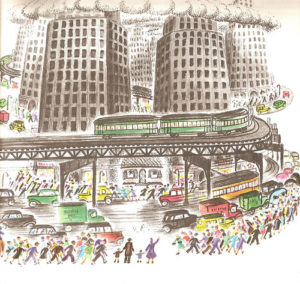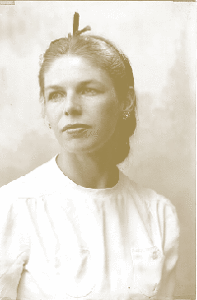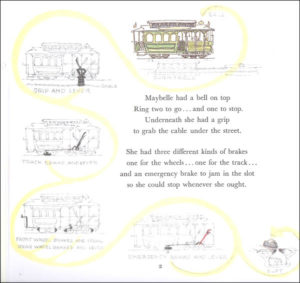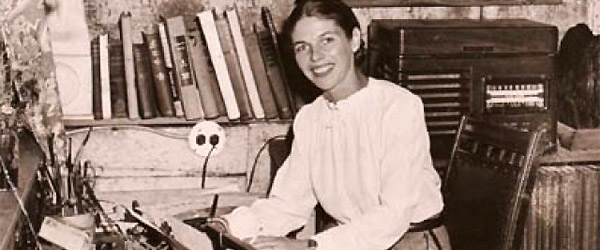
 Remember the scene in Pixar’s 2009 film Up where we see the sweet little house dwarfed by towering skyscrapers? That shot has always reminded me of a book I’ve loved sharing with my children: Virginia Lee Burton’s The Little House. In Up, the house is pulled up by an enormous colorful bouquet of balloons; in The Little House, the house is picked up on wheels and driven away by a family who loves it.
Remember the scene in Pixar’s 2009 film Up where we see the sweet little house dwarfed by towering skyscrapers? That shot has always reminded me of a book I’ve loved sharing with my children: Virginia Lee Burton’s The Little House. In Up, the house is pulled up by an enormous colorful bouquet of balloons; in The Little House, the house is picked up on wheels and driven away by a family who loves it.
Burton’s work has been a favorite of mine since childhood. I remember loving her most well-known book Mike Mulligan and His Steam Shovel when I was young. It was only when I had children that I explored the rest of her books and found the other treasures she left for young readers.
The Little House, Caldecott Medal winner of 1943, is a good example of the qualities you can expect to find in all of Burton’s work. She regularly explores themes of family, community, working together, and the potential unforeseen costs of progress. If you are looking for a Wendell Berry-esque storybook, you might start here. I often have a lump in my throat as I finish The Little House for the ump-teenth time; I love the sight of a home happy again with children running around it and apple trees swaying in the breeze.
 Burton worked at her prose until it sang to young hearts. Her books have a musical quality about them; many have repetitive prose or sound effects (Maybelle the trolley car goes “ting ting ting,” Katy the snowplow says “chug chug chug”). Most of the story of Maybelle actually rhymes. “Everyone hurried and seemed to be worried.” Yet at the same time, it provides a gentle introduction to civic action, as Burton recounts how the citizens of San Francisco petitioned the city for the trolley cars to stay a fixture in the town.
Burton worked at her prose until it sang to young hearts. Her books have a musical quality about them; many have repetitive prose or sound effects (Maybelle the trolley car goes “ting ting ting,” Katy the snowplow says “chug chug chug”). Most of the story of Maybelle actually rhymes. “Everyone hurried and seemed to be worried.” Yet at the same time, it provides a gentle introduction to civic action, as Burton recounts how the citizens of San Francisco petitioned the city for the trolley cars to stay a fixture in the town.
Burton would often read her drafts to her children and their friends and ask for their feedback. When they suggested edits, she went back to her desk and tried again. She felt that this prevented her from “writing down” to children, as so many storybooks are prone to do. In her words:
My first book, Jonnifer Lint, was about a piece of dust. I and my friends thought it was very clever but thirteen publishers disagreed with us and when I finally got the manuscript back and read it to Aris, age three and a half, he went to sleep before I could even finish it. That taught me a lesson and from then on I worked with and for my audience, my own children. I would tell them the story over and over, watching their reaction and adjusting to their interest or lack of interest . . . the same with the drawings. Children are very frank critics.
Another aspect of Burton’s work is her bent towards excellent design. She pored over pages, earnestly desiring that a book please the eye and tell the story alongside the words. Her pages frequently have tiny drawings around the
 borders that further explain the topic. Maybelle has parts of a trolley car in its border illustrations. Katy and the Big Snow has loads of tiny pictures of trucks and machinery. They are a kind of “I-spy” game for the attentive little reader. She even put a flat tire on a car in The Little House in one picture, because she knew her sons would notice (they did!). Burton’s illustrations are full of bold graphics, movement, and detail that serves her stories.
borders that further explain the topic. Maybelle has parts of a trolley car in its border illustrations. Katy and the Big Snow has loads of tiny pictures of trucks and machinery. They are a kind of “I-spy” game for the attentive little reader. She even put a flat tire on a car in The Little House in one picture, because she knew her sons would notice (they did!). Burton’s illustrations are full of bold graphics, movement, and detail that serves her stories.
Virginia herself was a lifelong learner. She and her friends founded a design guild out of Gloucester, Massachusetts, called the Folly Cove Designers. They were a craft guild dedicated to fabric design, and they were internationally renowned in the 1950’s. When she was in her 50s, Virginia, who had studied ballet when she was a young woman, decided to return to dance, taking lessons from a studio in her town. She continually worked to refine her drawing and design. When she was writing Maybelle, she spent so much time on trolley cars in San Francisco that she could operate one handily by the time the book was finished.
Virginia Lee Burton’s books have been a fixture in our home since my children were tiny. When I pulled them all out to review for this essay, my sixteen-year-old son sat down immediately with Katy and the Big Snow. It is a part of him now. I highly encourage you to seek out her books for your family!
For more about Burton:
Virginia Lee Burton: A Life in Art by Barbara Elleman
Big Machines: The Story of Virginia Lee Burton (a children’s biography, coming September 2017)
Virginia Lee Burton: A Sense of Place
Her books include:
Mike Mulligan and His Steam Shovel
Life Story (readers sensitive to discussions of evolution might skip this one)
Calico the Wonder Horse, or the Saga of Stewy Stinker
She also illustrated:
The Song of Robin Hood (1948 Caldecott Honor Recipient)
- A Winter Book Basket - February 7, 2024
- Review: While Everyone is Sleeping - October 25, 2023
- Some Keller Family Favorites - September 11, 2023

Aw, I love Mike Mulligan and Mary Ann! The illustrations transport me to my childhood.
I love it, too. The solution at the end is delightful.
This is so interesting! I loved hearing about her editing process. We’ve only read two of her books, so I’ll have to check out the others.
Yes, yes. Post-haste.
All three of our favorites! This reminds me that every time we close Little House Robert points to “ChooChoo” on the back and says “we should get this one!”
We are very thankful for Virginia Lee Burton!